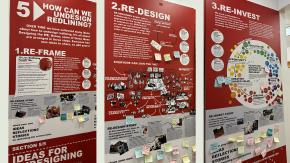
An interactive exhibit called “Undesign the Redline” walks participants through the history of systemic racism that has shaped America’s housing landscape while inviting us to imagine our role in designing a better future.
Just upstairs from the front entrance of Brooklyn’s Fifth Avenue Committee, large red panels of maps, photographs, words, and timelines sprawl across the walls of a common area. It’s a lot to take in—visually, emotionally, and morally. This is one of many spaces across the country where Designing the We’s “Undesign the Redline” lives. A traveling, interactive exhibit on the legacy of systemic racism in the United States’ housing system, walking through these panels is walking through our shared past, present, and possible futures.
Redlining was how structural racism and inequality was designed into cities. It has never been undone.
The exhibit starts by introducing redlining, a practice that baked systemic racism into the fabric of American cities and deprived people of color of the safe, stable housing and other basic opportunities granted to white residents. A short film called “Segregated by Design” maps out how those inequalities were deliberately constructed by federal, state, and local governments on a nationwide scale.
Source: Segregated By Design


The effects of redlining and the policies and practices that surrounded it are vast. They include everything from a persistent racial wealth gap to widespread disparities in health, legal system involvement, and eviction rates. Many of the people most affected by housing insecurity and poor living conditions today live in areas that once bore the brunt of redlining. Disinvestment and segregation have also had a lasting impact on challenges surrounding community safety. As viewers walk through the exhibit, they’re encouraged to reflect on how the aftermath of redlining continues to shape people’s lives in their own city.


One panel features a close-up redlining map of Brooklyn, New York, carved out into color-coded zones of red, yellow, blue, and green. They represent which areas were deemed worthy of critical investments and which weren’t, based on who lived there. Participants are invited to mark the map with a pin in the place they call home, seeing for themselves how their neighborhood has been impacted by the legacy of systemic racism or privilege.


At the center of the exhibit is a timeline spanning more than 200 years of the United States’ history. It is split in two: the top half features an interwoven string of oppressive policies and practices—from Jim Crow laws to workplace discrimination—that continue to shape our world today, while the bottom half traces stories of justice and resilience. As they take it all in, visitors are encouraged to fill in the gaps with untold stories and reflections of their own.

One story of justice featured on the wall is our Red Hook Community Justice Center, which offers people restorative pathways out of the legal system and helps residents of Red Hook, Brooklyn stay in strong, stable homes.

Another panel called “Stories from the Line” brings these histories to life even more vividly with stories and images from people and places around New York. In the open spaces in between, previous visitors to the exhibit have tagged the board with their own personal experiences and visions for a more just city.

The exhibit’s closing panel poses an urgent question: “How can we undesign redlining?” It suggests three key aspects of that mission: reframing our narratives, redesigning our systems and spaces, and reinvesting in communities that have been neglected and marginalized. Each of those goes to the heart of our housing work at the Center, which is rooted in the recognition that stable homes are the foundation of strong communities and key to fostering lasting public safety.

A speech bubble with the title “10 Lies Redlining Taught Me” challenges us to look in the mirror and examine our own responsibility in undesigning the redline.


